Marulanda J.M. (ed.) Electronic Properties of Carbon Nanotubes
Подождите немного. Документ загружается.

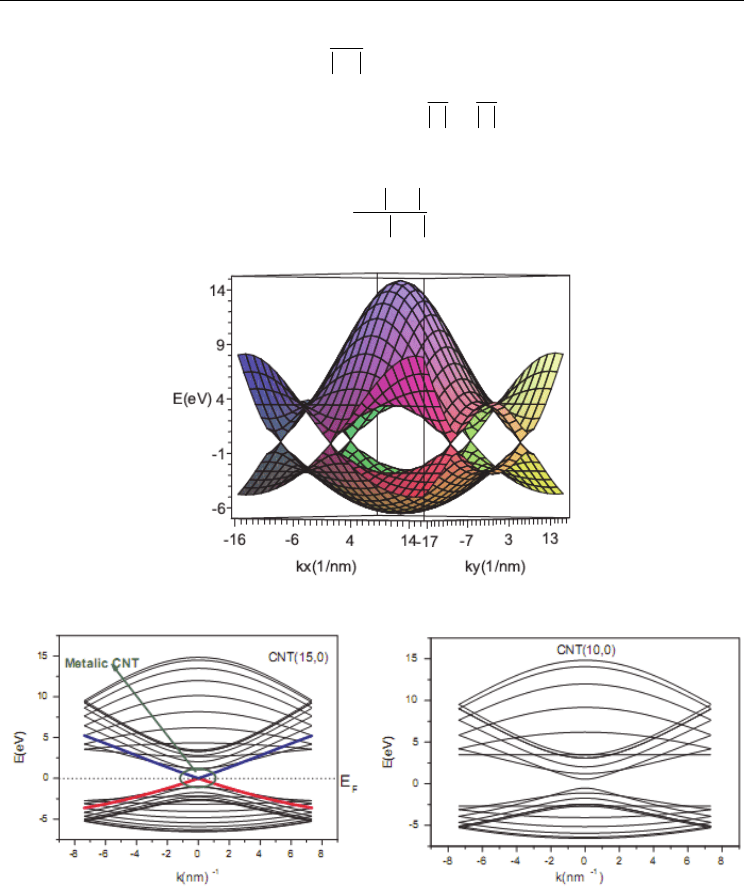
An Alternative Approach to the Problem of CNT Electron Energy Band Structure
415
K
(k K ),
K
0, ..., N-1. , k - ,...,
TT
CNT
K
(5)
Therefore, the band structure of CNT can be determined via;
f(K)
1 f(K)
E
s
(6)
Fig. 2. Graphene band structure.
Fig. 3. Electronic band structure of some CNTs based on TB model. The banding energy of π
orbital is equal to -3.03 eV and its overlap matrix is equal to 0.129. This figure clearly show
that CNT (15,0) is a metallic CNT. We will drive an important relation between the
geometry of CNT and its conduction. There is an important note. There are (N/2) + 1
degenerate levels in Zig-Zag CNT (n, 0).
Furthermore, density of State (DOS) of a one dimensional lattice with a lattice vector T and
for one level is given by [2]
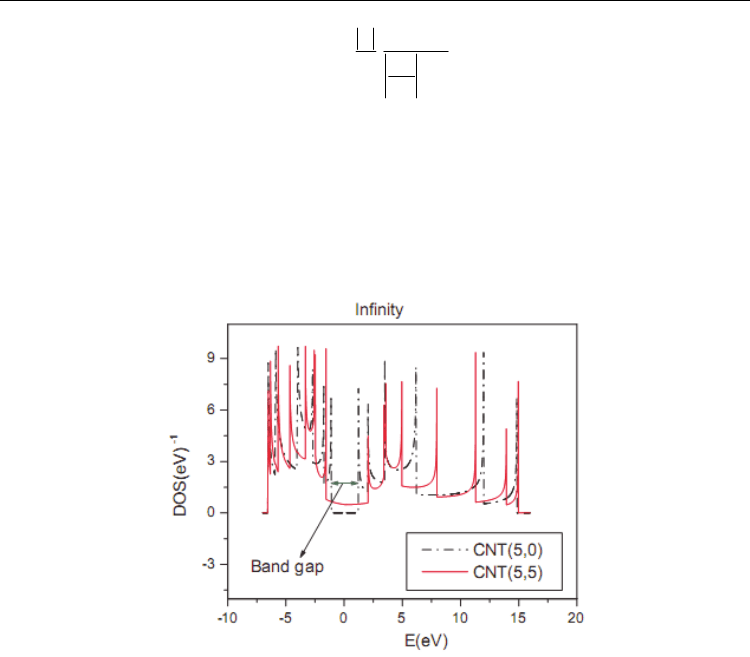
Electronic Properties of Carbon Nanotubes
416
i
1
g( ) .
i
i
E
T
E
k
(7)
i
DOS ( ) g ( )
i
(8)
Figure 4 Shows DOS of some CNT’s. As we see in this figure semiconducting Zig-Zag
CNT’s have not any density of state at the Fermi level but armchair CNT’s have a little
density of state at Fermi level. If we focused to the armchair CNTs at around Fermi level, we
find that the DOS has not treat as a constant value and treat as a parabola curvature.
Fig. 4. This figure compares density of state of a Zig-Zag CNT via as an armchair CNT. As
you see the Zig-Zag CNT has not any DOS near the Fermi level.
4. Augmented Plane Wave (APW) method
Slater introduced the APW method in 1937. Shortly after that researchers have used it for
determining the electronic band structure of the rocksalt lattice structure. Although APW
method is a sound one for calculating the band structure in metals, it has a great deal in the
past few years. In this method the influence of potentials from non – nearest neighbors is
taken into account.
As one can see in a schematic view in figure 5, the effective crystal potential is constant in
most of the open spaces between the cores. Therefore, we can begin by assuming such a
potential, which is referred to as the muffin-tin potential (because the potential is constant
there). The potential is that of a free ion at the core, and a plane wave outside the core.
Inside the core the function is atom-like, and is found by solving the appropriate
free-atom Schrödinger equation. Also, the atomic function is chosen such that it joins
continuously to the plane wave at the surface of the sphere forming the core; this is the
boundary condition. The wave function does not have the Bloch form, but this can be
remedied by forming the linear combination.
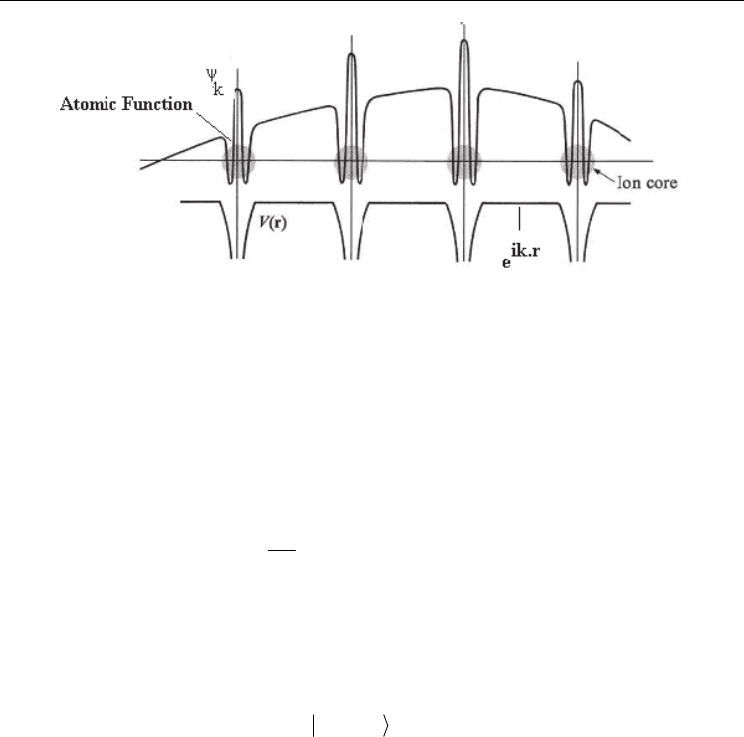
An Alternative Approach to the Problem of CNT Electron Energy Band Structure
417
Fig. 5. The potential and wave function in the APW method.
From the point of APW method view, the overlap of the wave functions centered, on the six
contact sites cannot be neglected, indicating that the atomic levels should be essentially
altered in a CNT. We thus assume that the bound levels of the atomic Hamiltonian are not
well localized, meaning the wave function is not small when
r (like the core radius ) exceeds
a distance of the order of the lattice constant
.
Therefore, we have to consider a many body system. The Schrödinger equation for a
many-electron system can be reduced to the effective one-particle problem for an
electron in a self-consistent field. Thus:
2
kkk
(- U(r)) ( ) E ( )
2m
rr
(9)
where U(r) is the crystal self-consistent potential, and ψ
k
and E
k
are the wave
function and the eigenvalue of the electron energy in k-state, correspondingly.
One of the main consequences of basis function over completeness is their linear
dependence. This means
m
G
kG G
G0
TPW 0C
(10)
If |G
m
| → 0, C
G
will indicate the numerical coefficients. Moreover, if C
G
≠ 0, the
transformed plane wave (OPW, APW) is denoted by the symbol |TPW
k+G
> , the wave
vector k belongs to the first Brillouin zone, and G are reciprocal lattice vectors. In the
method of linearized augmented plane waves (LAPW) the linear dependence of the
basis set |APW
k+G
> is manifested for R
0
G
max
≥ 9, which corresponds to accounting for
70-80 basis functions in APW, where R
0
is a muffin tin sphere radius. The OPW linear
dependence begins to be manifested if the number of basis functions is more than 100 in
(10) .
Although both APW and OPW, as two modern methods of band calculations, use
combinations of atomic functions and plane waves, they cannot yet yield to exact results. In
fact in the APW method, the wavefunction in general has discontinuous derivatives on the
boundary between the interstitial and atomic regions. It means that we have to consider
variational method in stead of Schrödinger equation. In this method, the augmenting

Electronic Properties of Carbon Nanotubes
418
function corresponds to the exact muffin-tin potential eigenstates of eigenenergy. Because of
this energy dependence of the augmenting function the eigenvalue problem will be non-
linear in energy and has to be solved iteratively. This is, however, computationally very
costly.
In addition, any eigenstate of a different eigenenergy will be poorly described without
adapting. Hence, we need to linearized versions of the APW method with modifying the
basis functions which gain extra flexibility to cover a larger energy region around their
linearization energy. In this view, the linear combinations of energy-independent APW as a
trial function and muffin-tin orbitals are inserted in the one-electron Hamiltonian. Then the
secular equations are therefore eigenvalue equations, linear in energy in that the energy
bands depend on the potential in the spheres through potential parameters which describe
the energy dependence of the logarithmic derivatives. Keep in mind that the energy-
independent APW inside the sphere is linear combination of an exact solution, which
matches continuously and differentiable onto the plane-wave part in the interstitial region.
5. Orthogonalized Plane Waves (OPW) method
OPW method, as a simplified version of the pseudo potential method [17], has been used
for the calculation of the electronic band structure of almost all types of solids with
neglecting nonlocal effects. It has been especially determining the band structure of
materials with covalent binding where the potential cannot be approximated by the
conventional muffintin construction. Indeed, OPW method is rather practical and time-
saving from the computational point of view since it leads to an eigenvalue problem
involving matrix elements which do not depend on the eigenvalues, as in other
methods of band theory. In contrast to above methods, in OPW method, the
eigensolutions can be found easily by conventional methods of linear algebra .
However, sometimes it cannot be used for calculating of nano scale materials due to the
structure of the secular problem arising in the OPW formalism which can be related to
a Born-series expansion, and it is known in scattering theory that resonances cannot
be appropriately accounted for in any order of such an expansion.
Two main approaches based on expansion have been used: (i) basis set and (ii) trial wave
function. Pseudo potential methods or OPW method use plane waves or modified plane
waves as the basis set. The TBM are based on the second concept. There are also approaches
which combine both delocalized and localized functions. In this approach the atomic-like
functions are squeezed by an additional attractive potential. The extention of the basis
functions is tuned by a parameter that can be found self-consistently [49]. The problem of
APW and OPW methods for a CNT structure is an abundance of multi- center integrals,
which must be performed to arrive at a reasonable accuracy of band structure calculations
due to existence of a great number of neighbours within a given distance. To avoid these
difficulties, we have tried to introduce an alternative method (see next section).
In our method we consider a lot of plane waves in the basis to decrease the spatial extent of
localized valence orbitals in CNT. We could take a method far beyond usual pseudo
potentials and improve our plane-wave basis set. The results show a good converged Bloch
function for both valence electrons and excited states using a relatively small number of
plane waves.
Two separated core orbital contributions and plane wave contributions, which are not
OPWs at the outset have been involved in this approach, so that in the basis set three types

An Alternative Approach to the Problem of CNT Electron Energy Band Structure
419
of functions are used: true core orbitals, squeezed local valence orbitals and plane waves. If
a larger number of plane waves are included in the band structure calculations, there is
usually the reason for the over-completeness breakdown of OPW expansions. The local
basis function (both core and valence) can be constructed from radial functions, which are
solutions of the radial Schrödinger equation. Our approach provides a full interpolation
between the APW and OPW approaches adopting pseudo-potential features [18].
It is clear that there is an intense overlapping between electron wave functions of CNT when
carbon atoms come close to each other, whilst in OPW method, each electron are imagined
as a nearly free electron. Obviously, the above assumptions cannot explain behavior of the
electron when carbon atoms come together like d-layer electrons.
6. A new method
One approach to overcoming these impending barriers involves finding on evaluating the
potential of CNTs as the basis of a future nanoelectroncs technology. Single-walled CNT
(SWCNTs) are materials with unique properties. They have several millimeters in length
and are strongly bonded covalent materials. Because of their extremely small diameter, the
OPW method should be modified and completed with TB method, with considering the
overlapping of wave function of electrons. The procedure is to augment the basis set of
present method by including wave functions which are OPWs between nuclei of carbon
atoms but represent modified Bloch waves near the nuclei. It means that by scaling the CNT
dimension, the carbon atoms come close to each other and change the band energy. Thus, by
using Ritz variational method, we have modified the band energy.
Nothing said up to now has exploited any properties of the potential U( r) other than its
periodicity, and, for convenience, inversion symmetry. If we pay somewhat closer attention
to the form of U, recognizing that it will be made up of a sum of atomic potentials centered
at the positions of the carbon atoms, then we can draw some further conclusions that are
important in studying.
There is the other view, known the electron correlations. In fact, the existence of a unique
density function which yields the exact ground state energy may not cause the possibility of
reducing the many – electron problem to the one – electron one. This is due to at least the
Coulomb interaction among electrons, in where at weaker electron correlations, it can
involve a self – consistent potential which depends on electron density. In fact, the
correlation effects near to carbon cores in where the strong intrasite Coulomb repulsion may
lead to splitting of one – electron bands into many – electron subbands meaning TBM is
inapplicable.
On one bands, nearest neighbor carbon atoms may share and/or transport electrons so that
electrons become localized at carbon sites. In a such a situation of CNT, we need to modify
the eigen functions and introduce a correction term by expressing them in terms of many –
electron and/or overlapping functions of the atomic problem. It depends on many electron
quantum numbers, s, L occurs in the full Hartree – Fock approximation [8].
Let us have a somewhat closer look at the band structures. The constructions reported so far,
imply that there is just an electron as a localized particle (and completely free electron) if
there are sufficiently many Bloch waves available. This is not necessarily the case in nano
structures due to localization of electron with building a localized wave packet from the
Bloch waves. It leads the sharply peaked character of the weight function and the spatial
extension of such an electron wave packet which can be larger than the lattice constant.

Electronic Properties of Carbon Nanotubes
420
In the Ritz method, the minimizing element in the n-th approximation is sought in the linear
hull of the first n coordinate elements. The Ritz ansatz function is a linear combination of N
orbitals. Based on linear combination of atomic orbital (LCAO) approximation,
()r
is
j
(r) ( )
j
r
(11)
The eigenvalues and eigenvectors can be found with finding a solution of the Ritz method. It
is widely applied when solving eigenvalue problems, boundary value problems and OPW
equations in general. The trial wave function will always give an expectation value larger
than the ground energy (or at least, equal to it). It is known to be orthogonal to the ground
state.
Further development of the OPW method led to the idea of introducing a weak pseudo
potential which permits (unlike the real crystal potential) the use of perturbation theory.
Because of strong core level potential within it, it may be represented in the form of a new
Schrödinger equation where the non-local energy-dependent pseudo potential operator W is
defined by
R
W V(r) V (12)
Although OPW method with pseudo potential principle a possibility to eliminate the
difficulty pointed before, it is rather complicated and goes far beyond the original concept of
the CNT band – structure methods due to requiring exact diagonalization of a matrix of the
pseudo potential idea – applicability methods may not provide as a rule sufficiently
satisfactory description of CNT.
To overcome of these difficulties, KKR method has been used. The advantage of the KKR
method in comparison with the APW one is the decoupling of structural and atomic factors.
For the same lattice potentials, the KKR and APW methods yield usually close results.
However, the main difficulty of the KKR method is the energy dependence of the structural
constants.
In the general APW, KKR and LCMTO (MT: Mofin Tin) methods, the matrix elements are
functions of energy. Therefore, at calculating eigenvalues one has to compute the
determinants in each point of k-space for large number values of E (of order of 100) which
costs much time.
In the present work, according to Andersen theorem [2], we expand the radial wave
functions at some energy value to linear terms in E, in which, both Hamiltonian and
matrices do not depend on energy. We can get more accuracy by amount of higher – order
terms in the expansion. Using this idea, we will be able to improve considerably the
accuracy of CNT – band energy and achieve very good results.
In this case we deform new wave function based on OPW and TB methods, in that the
carbon atoms cores are placed in the crystal lattice sites R. There are localized electrons
and the lattice sites. Henceforth, the core electron wave functions can be assumed to be
approximately equal to the corresponding Hartree-Fock functions of a free atom, that
is,
Cr HF
ii
() ()rR rR (13)
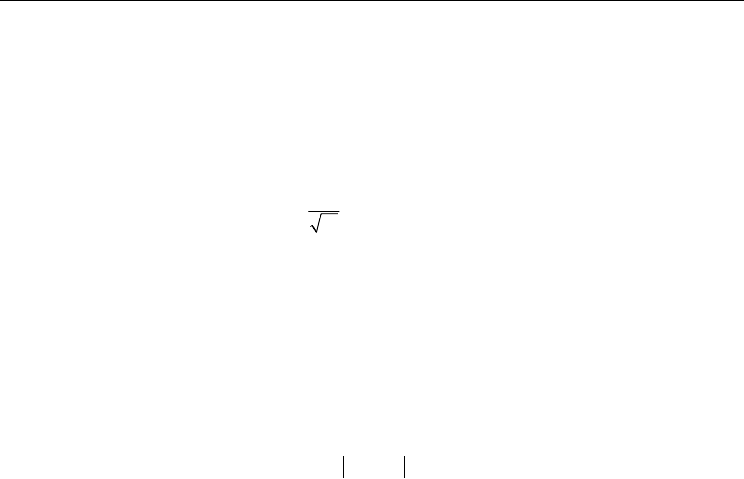
An Alternative Approach to the Problem of CNT Electron Energy Band Structure
421
where I = n, I, m is a set of quantum numbers which characterize bound electron states.
HF
i
()rR
are localized to such an extent and the overlap of
HF
i
()rR
centered in
different sites should be ignored, which leads:
*
i
()( ) ( )
iii
rR rRdr RR
(14)
On the other hand, for N unit cells in CNTs, u(k
i
; r) can be written by the following expression:
n
. R
nlm n
1
(,) ( - R)
N
i
ik
i
j
uk r e r
(15)
where R
n
is the distance between two nearest neighbor carbon atoms. It yields new
orthogonalized coefficients. We consider a correction term as L
ij
;
i
j
i
j
i
j
i
j
M (k . k - E) L
(16)
By using separable variables method, the atomic wave functions,
()
nlm
r
, split into a set of
radial R
nl
(r), azimuth angle part
()
m
and associated Legendre equation P
lm
(x), with x =
cos
ө. After doing some calculations on solving the above equation, the electronic band
energy is determined by the following equation;
det H - EP 0
(17)
Where
OPW
is
is
HH
H
H
ij
ss
H
(18)
And
OPW
is
is
PP
P
P
ij
ss
P
(19)
Finally, the overlapping wave functions of SWCNTs is demonstrated by H and P matrices,
3
is i s q sq
0
H () u(,) d - a b
q
q
rH kr r E
(20)
3
ss' i s s' sq s'q
0
H () u(,) H u(,) d - b b
q
q
rkr krrE
(21)
And
3
is i s q sq
0
P ( ) u ( , ) d - C b
q
rkrr
(22)
3
ss' i s s' sq s'q
0
P () u(,) u(,) d - b b
q
rkr krr
(23)

Electronic Properties of Carbon Nanotubes
422
Where
.
3
sq s n
0
b () ( R) d
n
ik R
q
q
err r
(24)
We found a reliable matrix which can describe the CNT electron behavior with doing the
series of calculations based on the Ritz variational, OPW and TB methods. In this method,
there is no limitation on crystalline potential of CNT structure, so it can be suggested for
evaluating the electronic band energy of SWCNTs.
Therefore, the wave functions, which enter the Slater integrals, are based on self – consistent
way from the corresponding integro – differential equations. It means the one – electron
Hamiltonian of CNT in the many – electron representations, should take into account the
electron transfer owing to matrix elements of electrostatic interaction, which will be more
complicated in solving the CNT –atomic problem. Moreover, the general Hartree - Fock
approximation may give us the radial one - electron wave functions which depend explicitly
on atomic term, whilst these wave functions can not be factorized into one - electron ones, or,
the interaction of different carbon electron on the other sites is sometimes required.
Thus we cannot describe unlocalized electron states in CNTs within above methods. In
contrast to TBM, the strength of CNT potential can determine the widths of gaps rather than
of electron bands ( as addressed in TBM).
7. References
[1] A. Bahari, P. Morgen, Z.S. Li and K. Pederson, J. Vac. Sci. and Tech. B, 24 (2006) 2119.
[2] A. Bahari and M. Amiri, Acta physica Polonica A , 115 (2009) 625.
[3] A. Bahari, U. Robenhagen, P. Morgen and Z. S. Li, Phys. Rev. B, 72 (2005) 205323.
[4] A. Bahari, P. Morgen and Z.S. Li, Surf. Sci., 602 (2008) 2315.
[5] F. M. Nakhei and A. Bahari, Int. J. Phys. Sci , 4 (2009) 290.
[6] A. Bahari, P. Morgen and Z.S. Li, Surf. Sc., 600 (2006) 2966.
[7] P. Morgen, A. Bahari and. Pederson, Functional properties of Nano structured Material,
Springer, pp: 229-257, 2006.
[8] R. K. Lake and R. R. Pandey, Handbook of Semiconductor Nanostructures and Devices, Los
Angles: American Scientific Publishers, 2006.
[9] M. Brandbyge, J.-L. Mozos, P. Ordejón, J. Taylor, and K. Stokbro, Phys. Rev.B, 65
(2002) 165401.
[10] L.W. Wang, Phys. Rev. B, 49 (1994) 10154.
[11] M. P. Anantram, M. S. Lundstrom, and D. E. Nikonov, cond-mat/0610247, 2006.
[12] R. Lake, D. Jovanovic, and C. Rivas, Nonequilibrium Green's Functions in Semiconductor
Device Modeling (NewJersey), pp. 143-158, World Scientific, 2003.
[13] L.-H. Ye, B.-G. Liu, D.-S. Wang, and R. Han, Phys.Rev.B, 69 (2004) 235409.
[14] J. Kohanoff, Electronic Structure Calculations for Solids and Molecules, Cambridge
University Press, (2006).
[15] Ch. Kittel, Introduction to Solid State Physics, Chapter 7. John Wiley & Sons, Inc., (2005).
[16] http://en.wikipedia.org/wiki/Electronic_band_structure.
[17] O. Krogh Andersen, Phys. Rev. B, 12 (1975) 3060.
[18] A. Ernst and M. L¨uders , Methods for Band Structure Calculations in Solids, Springer-
Verlag Berlin Heidelberg 2004.
20
Electronic Structure and Magnetic
Properties of N@C
60
-SWCNT
Atsushi Suzuki and Takeo Oku
The University of Shiga Prefecture
Japan
1. Introduction
Single-walled-carbon nanotube (SWCNTs) encapsulating fullerenes as peapods have been
considerably interested to apply organic field effect transistor, magnetic device and
quantum device (Bailey et. al. 2007, Khlobystrov et. al. 2005). Electronic structure and
physical properties of fullerenes within SWCNT as carbon peapods has been studied. Table
1 lists recent works. For instant, the endohedral metallofullerenes nested in the strained
nanotube have the electronic structure with the relative energy levels at the different states
and produces a spatial modulation of the energy gap (Cho et. al. 2003). A scalable spin
quantum computer that combines aspects of electronic and magnetic properties of
endohedral fullerenes that enclose small clusters of metal atoms, such as Sc
2
@C
84
, La@C
82
(as
shown in Fig. 1) and Gd@C
82
, N@C
60
and P@C
60
encapsulated within SWCNT as peapods
has been investigated (Tooth et. al. 2008, Cantone et. al. 2008, Warner et. al. 2008, Cho et. al.
2003, Yang et. al. 2010). The key advantages are that magnetic interactions between
electronic spins and nuclear spins in carbon peapods are used. As an example using
nitrogen endohedral fullerene N@C
60
encapsulated within SWCNT as peapods (see Fig. 2),
the nitrogen atom occupies a high-symmetry site at the center of the cage and retains its
atomic configuration, and the cage offers protection of the nitrogen electron paramagnetic
moment, which is related to electron spins, S=3/2, coupled to be nuclear spin I=1. This
material has a high advantage of the NMR quantum computer to control spin gate with
decoupling pulses in relaxation time. Morton reported the NMR quantum-computer
controlled un-perturbation Rabi oscillation of spin polarization under influence of
decoupling process (Morton, et. al. 2005, 2006, 2011). Additionally, nitrogen endohedral
fullerene
14
N@C
60
encapsulated within SWCNT allow to control quantum qubit-gate under a
mixture of biding interaction between electron and nuclear spins in the NMR quantum
computing. Recently, Yang reported how to efficiently implement the quantum logical gate
operations required for universal quantum computation. Transfer of information between
qubits had been considered by direct dipole-dipole couplings or by using a mobile electron
spin as the bus qubit (Yang et. al. (2010), Meyer et. al. (2004)).
The band structures for infinite periodic chains of C
60
and N@C
60
are shown in Fig. 2. All the
energies are given in units of E -E
F
for each system. The effects of encapsulated nitrogen on
the band structure of C
60
have been considered. The results reveal that the nitrogen causes
the lowering of the C
60
at the LUMO and HOMO levels together with a splitting of the
degenerate levels.
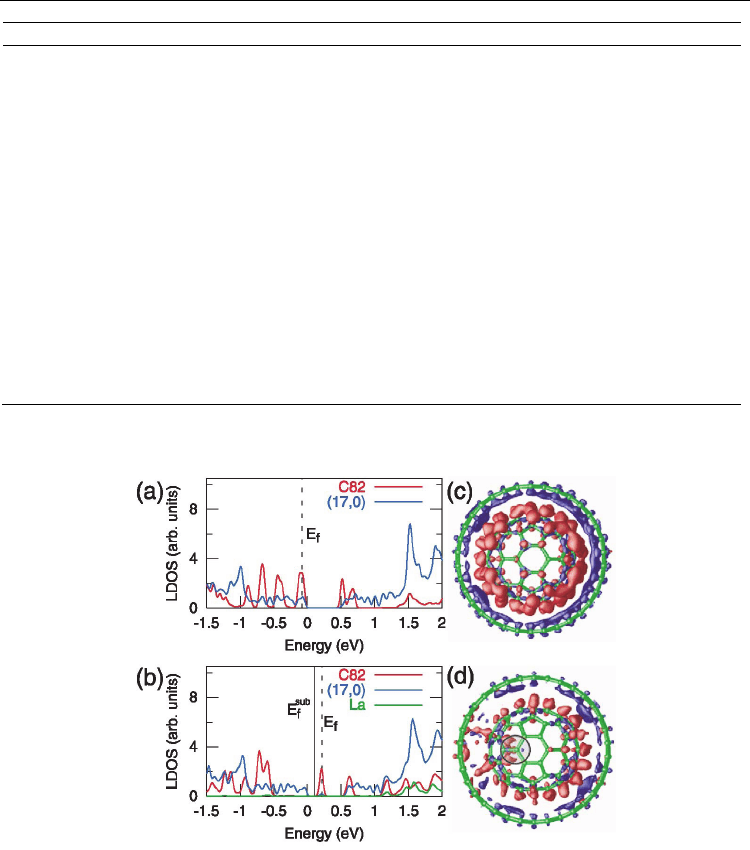
Electronic Properties of Carbon Nanotubes
424
Contents References
Fullerene-based quantum computer
Morton et. al. (2005), (2006), (2011), Yang et.
al. (2010)
Harneit et. al. (2002), Meyer et. al. (2004),
Benjamin et. al. (2006)
N@C
60
-SWCNT, P@C
60
-SWCNT Cho et. al. (2003), Bailey et. al. (2007), Jue et.
al. (2007),
Simon et. al. (2006) (2007), Tooth et. al,. (2008),
Yang et. al. (2010), Suzuki et. al. (2010), Iizumi
et. al. (2010)
Sc@C
82
-SWCNT, La@C
82
-SWCNT Cho et. al. (2003), Cantone et. al. (2008),
Warner et. al. (2008)
Carbon tubes Rao et. al. (1997), Khlobystrov et. al. (2005)
C
60
Schiller et. al. (2006)
N@C
60
, P@C
60
, (C
59
N)
2,
C
59
N
Buhl et. al. (1997), Fulop et. al. (2001),
Kobayashi et. al. (2003),
Abronin et. al. (2004), Schulte et. al. (2007)
Table 1. Electronic structure and physical properties of fullerenes within SWCNT as carbon
peapods
Fig. 1. Local density of states (LDOS) of (a) C
82
@(17, 0) and (b) La@C
82
@(17, 0) decomposed
into the constituents. Black vertical lines indicate the Fermi level (Ef). E
sub
f
represents the
Fermi level with the metal substrate in contact. Isodensity surface plots of the electron
accumulation (red) and depletion (blue) are shown for C
82
-SWCNT (17, 0) and La@C
82
-
SWCNT(17, 0) in (c) and (d), respectively. The values for the red and blue surfaces in (c) are
±0:0035e/eÅ
3
. Corresponding values in (d) are ±0:0025e/eÅ
3
. The gray circle in (d) indicates
the position of the La atom inside C
82
. (Cho et. al. (2003))
The gap between HOMO and LUMO is reduced from 1:8 eV of C
60
to 1:66 eV of N@C
60
. The
effects of majority and minority spins in the nitrogen basis were found not to have any
